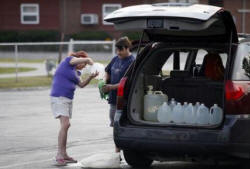|
 Some
400,000 in Ohio without drinking water, tests show lower toxin levels Some
400,000 in Ohio without drinking water, tests show lower toxin levels
 Send a link to a friend
Send a link to a friend
[August 04, 2014]
By George Tanber
TOLEDO Ohio (Reuters) - Health authorities
tested water for toxins in Toledo, Ohio, on Sunday as some 400,000
people remained without safe drinking water for a second day following
the discovery of high toxin levels from algae on Lake Erie.
|
|
 Toledo Mayor D. Michael Collins said some sampling showed
decreased toxin levels but results from further tests would not be
known until later in the day. The city is waiting on water samples
being analyzed at Environmental Protection Agency labs in
Cincinnati. Toledo Mayor D. Michael Collins said some sampling showed
decreased toxin levels but results from further tests would not be
known until later in the day. The city is waiting on water samples
being analyzed at Environmental Protection Agency labs in
Cincinnati.
"All I can tell you is that everything is trending in a very
positive direction," Collins told reporters, but he added that he
could not predict when water would be safe to drink.
About 500,000 people get water from the contaminated source but
about 100,000 residents of some communities have backup water supply
systems, said city of Toledo spokeswoman Lisa Ward.
Toledo Public Utilities Director Edward Moore said a plan is in
place to swiftly flush the system of contaminated water once the
water supply is deemed safe. Residents will be advised how long to
run water in their homes to clear pipes of contaminated water.
Health officials sent samples to several laboratories after finding
Lake Erie, which provides the bulk of the area's drinking water, may
have been affected by a "harmful algal bloom," Ohio Environmental
Protection Agency spokeswoman Heidi Griesmer said.

Ohio Governor John Kasich declared a state of emergency on Saturday
for the state's fourth-largest city and surrounding counties. The
city and other agencies have established sites where bottled water
is being distributed free to the public.
"Everybody needs to stay cool and calm," Kasich told a news
conference on Sunday. "We’re going to learn from this and make
improvements."
SEEKING SAFE WATER
Many residents drove to other states in search of fresh water as
stores rapidly sold out of bottled water.
Jeff Hauter of Toledo drove to a Walmart in suburban Detroit where
he bought 18 gallons and four cases of water. He said he ran into
others from the Toledo area loading up their vehicles.
[to top of second column]
|

Algal blooms in Lake Erie are fairly common, typically in the
summer, state emergency operations spokesman Chris Abbruzzese said.
Potentially dangerous algal blooms, or rapid increases in algae
levels, are caused by high amounts of nitrogen and phosphorous.
Those nutrients can come from runoff of excessively fertilized
fields and lawns or from malfunctioning septic systems or livestock
pens, city officials said.
Drinking the contaminated water can affect the liver and cause
diarrhea, nausea, numbness or dizziness, officials said. Boiling
will not destroy the toxins.
The water should not be used for drinking, making infant formula or
ice, brushing teeth or preparing food, the governor's office said.
It also should not be given to pets, but hand washing is safe and
adults can shower in it, officials said.
In response to the Toledo crisis, Chicago began additional
precautionary testing on Lake Michigan water, a city spokeswoman
said.
(Reporting by George Tanber in Toledo, Alex Dobuzinskis in Los
Angeles, Kevin Murphy in Kansas City and Mary Wisniewski in Chicago;
Writing by Curtis Skinner and Kevin Murphy; Editing by Jane Baird,
Tom Heneghan and Mohammad Zargham)
[© 2014 Thomson Reuters. All rights
reserved.] Copyright 2014 Reuters. All rights reserved. This material may not be published,
broadcast, rewritten or redistributed.
 |